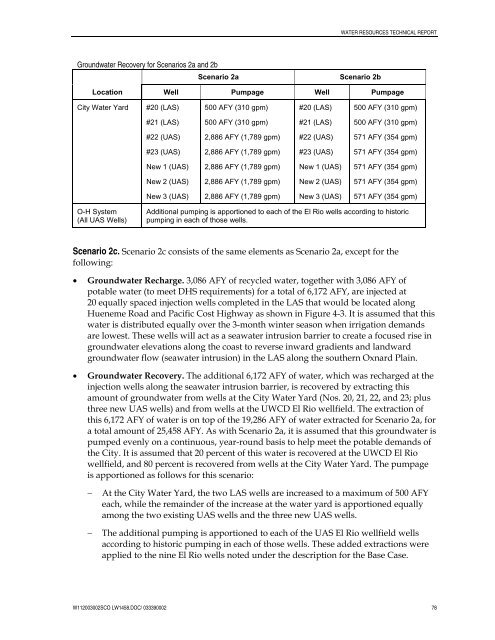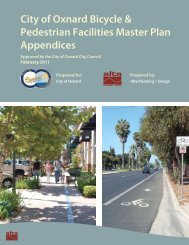View File - Development Services - City of Oxnard
View File - Development Services - City of Oxnard
View File - Development Services - City of Oxnard
You also want an ePaper? Increase the reach of your titles
YUMPU automatically turns print PDFs into web optimized ePapers that Google loves.
WATER RESOURCES TECHNICAL REPORTGroundwater Recovery for Scenarios 2a and 2bScenario 2aScenario 2bLocation Well Pumpage Well Pumpage<strong>City</strong> Water Yard#20 (LAS)500 AFY (310 gpm)#20 (LAS)500 AFY (310 gpm)#21 (LAS)500 AFY (310 gpm)#21 (LAS)500 AFY (310 gpm)#22 (UAS)2,886 AFY (1,789 gpm)#22 (UAS)571 AFY (354 gpm)#23 (UAS)2,886 AFY (1,789 gpm)#23 (UAS)571 AFY (354 gpm)New 1 (UAS)2,886 AFY (1,789 gpm)New 1 (UAS)571 AFY (354 gpm)New 2 (UAS)2,886 AFY (1,789 gpm)New 2 (UAS)571 AFY (354 gpm)New 3 (UAS)2,886 AFY (1,789 gpm)New 3 (UAS)571 AFY (354 gpm)O-H System(All UAS Wells)Additional pumping is apportioned to each <strong>of</strong> the El Rio wells according to historicpumping in each <strong>of</strong> those wells.Scenario 2c. Scenario 2c consists <strong>of</strong> the same elements as Scenario 2a, except for thefollowing:• Groundwater Recharge. 3,086 AFY <strong>of</strong> recycled water, together with 3,086 AFY <strong>of</strong>potable water (to meet DHS requirements) for a total <strong>of</strong> 6,172 AFY, are injected at20 equally spaced injection wells completed in the LAS that would be located alongHueneme Road and Pacific Cost Highway as shown in Figure 4-3. It is assumed that thiswater is distributed equally over the 3-month winter season when irrigation demandsare lowest. These wells will act as a seawater intrusion barrier to create a focused rise ingroundwater elevations along the coast to reverse inward gradients and landwardgroundwater flow (seawater intrusion) in the LAS along the southern <strong>Oxnard</strong> Plain.• Groundwater Recovery. The additional 6,172 AFY <strong>of</strong> water, which was recharged at theinjection wells along the seawater intrusion barrier, is recovered by extracting thisamount <strong>of</strong> groundwater from wells at the <strong>City</strong> Water Yard (Nos. 20, 21, 22, and 23; plusthree new UAS wells) and from wells at the UWCD El Rio wellfield. The extraction <strong>of</strong>this 6,172 AFY <strong>of</strong> water is on top <strong>of</strong> the 19,286 AFY <strong>of</strong> water extracted for Scenario 2a, fora total amount <strong>of</strong> 25,458 AFY. As with Scenario 2a, it is assumed that this groundwater ispumped evenly on a continuous, year-round basis to help meet the potable demands <strong>of</strong>the <strong>City</strong>. It is assumed that 20 percent <strong>of</strong> this water is recovered at the UWCD El Riowellfield, and 80 percent is recovered from wells at the <strong>City</strong> Water Yard. The pumpageis apportioned as follows for this scenario:−−At the <strong>City</strong> Water Yard, the two LAS wells are increased to a maximum <strong>of</strong> 500 AFYeach, while the remainder <strong>of</strong> the increase at the water yard is apportioned equallyamong the two existing UAS wells and the three new UAS wells.The additional pumping is apportioned to each <strong>of</strong> the UAS El Rio wellfield wellsaccording to historic pumping in each <strong>of</strong> those wells. These added extractions wereapplied to the nine El Rio wells noted under the description for the Base Case.W112003002SCO LW1458.DOC/ 033390002 78
















